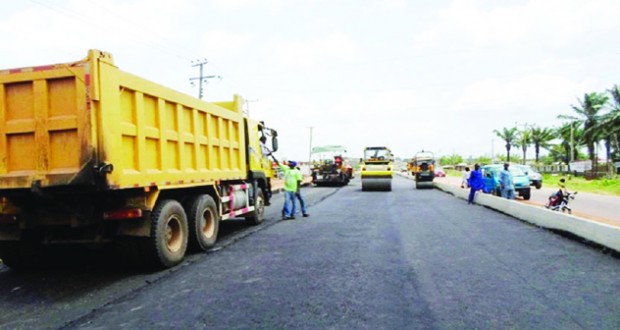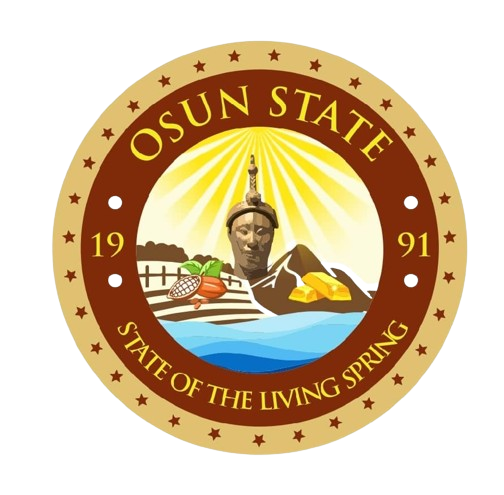
OPINION: Osun’s ‘Road’ To Economic Recovery

The government of the state of Osun says it is building multi channel roads, which it believes will stimulate economic prosperity. Seun Akioye looks at how the road projects have affected the common Joe.
It was not a political rally. Not yet. It was a different kind of rally, one that the supporters called ‘the peoples’ rally. At about 3:00pm on April 15, 2014, Governor Rauf Aregbesola rode into the city of Ilesa in an open roof white Sport Utility Vehicle (SUV) and a convoy of about six vehicles. He was dressed in a white lace that fitted his modest frame and a blue cap, sat proudly on his head; a dark sunshade protected his eyes from the blinding rays of the sun. Immediately, a crowd gathered and as the convoy progressed into the heart of the city, thousands of enthusiastic supporters joined in forcing it to move at a snail’s pace.
The governor waved at the people, sometimes gave the victory sign and danced to the impromptu music of the Okada riders and other supporters, who ran alongside his motorcade. He bonded with the people who felt they could honestly lay claim to him as one of their own.
In the last one year, Aregbesola’s administration has built 29.71 kilometres of roads round Ilesa. The new roads are on 15 streets. It is like a ring road connecting different sections of the city, so that if one began from one end, one could end up at the same spot going round the city. That was what Aregbesola did when he rode into town to open the roads. He spent over one hour inspecting all 15 roads and ended up at the Ibala Road Community Primary School, venue of the ceremony, where several thousands of people were already waiting. Time was 4:30pm.
Aregbesola said his overriding ambition is to regain Osun’s place as the economic hub of the Southwest, outside of Lagos and because the state is bordered by five states of the Southwest and the North central, it serves as a veritable alternative to Lagos in trade and investments. So, the governor thought of linking the state with the railway and constructing standardised access roads into the state. The road construction too would serve as internal economic stimulus for the state.
So, almost four years into this plan, how has the state managed to achieve its objectives?
“We just want the roads fixed”
Government agencies said that the construction of 15 roads in Ilesa was unprecedented in the history of the state. Instructively, many of the residents shared this sentiment. At the ceremony to mark the commissioning of the roads, about 15 traditional rulers, both within the state and outside, graced the occasion. Speaking for the royal fathers, the Owa Obokun of Ijeshaland, Oba Adekunle Arom-olaran said, the administration of Governor Aregbesola has made the biggest developmental impacts in the state. He mentioned the constructed roads as being unprecedented and threw in a clincher. “I can even say it was during your administration that I gave birth to twins,” he told the governor.
But, it wasn’t only the royal fathers that appreciated the benefits of the new roads in Ilesa, the people do too. Mary Oyeleye, a resident of Omo-Olupe Street, Bonnke area, just opened a new business where she sells food items. About a year ago, this had been impossible to accomplish and the reasons are not far-fetched.
“We have really suffered in this Olupe Street. Before the road was constructed, this whole area was flood and muds especially the Bonnke area. There was a river there and only Okada could pass through this area, when you get to Bonnke, then you have to roll up your dress and wade through the mud and river. There were houses that have been submerged in the river too. This place was a nightmare,” she said.
The bad condition of the road also had its negative economic impact. Being a major link road to several towns including Ijebu-Ijesa, Osogbo and Akure, the road had been completely deserted by all commercial interests, shops closed down and residents began to move out of the area.
About a year ago, work began on the road and when the construction was completed the area took on a new image. Apart from the standard construction, Omo-Olupe Street has opened for business. “We built these stores last December because the road is now passable. Also, all the commercial buses are now using this road, so it makes it busy. We are grateful to the governor for doing this; he has totally changed our lives,” Oyeleye said.
Omo-Olupe is not the only street opened for business, the whole of Ilesa is. From one street to the other, residents spoke of years of decay and neglect but which has been reversed by the construction or rehabilitation of the roads. Omi-Eran road for instance, according to some of the engineers from Ratcon Construction company – the company responsible for the construction of the roads – was a terrible specimen of a township road.
At the ceremony to commission the roads, the residents discussed the impacts of the new developments in the city. They were not the only ones to marvel in wonder, the governor did too. “As we drove round the roads today with the people, I was just wondering about what God can do. I was thinking to myself that to have 29 kilometers of roads round Ilesa, this is the first time in the history of this state. I was just thanking God,” the governor said. His eyes dilating with excitement and his voice rising in a sing-song. The crowd caught the bug of his excitement and somebody raised a song loosely translated to thanking God for a new era.
The excitement about the new roads, however, transcends Ilesa, in Osogbo, where several township and inter-city road constructions have been done and still ongoing, the physical outlook of the city has changed, probably forever. In Osogbo, the philosophy behind the road constructions remains the same; that is, opening up economic opportunities for many of the residents of the state, from the bottom up approach.
Mercy land area, a large residential and business settlement in Osogbo, with thousands of residents now wears a new look. It is one of the several Osogbo township roads constructed over four months ago, which linked several neighbourh-oods. In Mercy land area, which conveniently sits on a small hill, there are about 10 newly constructed roads, linking one street with another up and down the hill.
Kayode Oyediran has operated his tie and dye business from Omonike crescent for five years now but according to him it was only this year that any meaningful improvement has occurred in the area. “Because the whole of Mercy land area was in a terrible shape, you find that people cannot move as freely as they want. The consequence of that is business concerns were affected. It was only those who had Okada that could work here,” he said.
But things have changed for his business. Because of the newly constructed roads in the neighbourhood he could easily move his raw materials into site and also his finished goods out of his business premises. “I think on the issues of road construction, I will give the governor a pass mark. This is not the only road he has done, if you go across Osogbo, there are so many inner roads like this that have been done. Osogbo has really changed,” Oyediran enthused.
The residents of Oke-Arugbo’s 12 zones neighbourhood also believe their newly constructed roads will facilitate business development in the area and boost real estate.
According to Chief Titus Osobu, the chairman of the All Progressives Congress (APC), Atakumosa West, in Ilesa, but who owns a house in Oke-Arugbo zone 2, the development in the area has been unprecedented. “I came here about 20-years ago but this type of development has been unprecedented. There were times we had given up, but today, we thank Governor Aregbesola for doing this road for us.
“We never expected our road will be fixed in 10 years, this governor has really tried and we really appreciate him for that. Tell him we are grateful recipients of all that he is doing,” Titilayo Adetoun, a resident of zone 3, who followed the profession of tailoring said.
Though the construction of roads in Oke-Arugbo still has about four zones to be completed, the revolution was already catching on in all the zones. “Zone 8, where I live is yet to be constructed, but we can drive on good roads up to this point. We are certain the government must complete all the remaining roads to have a complete development,” Mrs. Adebola Adeseye said.
Outside the township roads in Osogbo, there are major inter–city construction being undertaken by the Aregbesola administration. One of the major road constructions embarked upon is the famous Oba Adesoji Aderemi bypass.
The story behind this massive 17.5 kilometer road within Osogbo metropolis is as interesting as the construction itself. According to government officials, the aim of the road is to complete the Ring road round Osogbo.
Sabitu Amuda, an engineer and Special Adviser to the Governor on Works is the man in charge of the various road constructions. The Oba Adesoji bypass is one of the projects that give him some of the most pleasure and when he talks about it, it shows.
“It’s a roundabout that connects Iwo road and the West by-pass. It ended there before, but we now want to complete the loop, we want to finish the ring. It starts from Iwo road roundabout and goes the whole of 17.5 kilometers to link back to the roundabout at Ikirun road, so that you have a complete Ring road round Osogbo,” he said.
Going through the length of the on-going construction is instructive about the determination of the government to bring massive development to that part of the city. A Turkish construction company, Slava-Yeditepe had the task of boring through rocks and wading through rivers to construct the new bypass. From Iwo roundabout to Channel 0, work according to government is about 40 percent completed.
When The Nation visited the site, workers were seen engaged in the road work. Between channels 0-4, new bridges were springing up over railways and dual carriage ways took the place of deep forests. At Abere junction, a flyover would pass over it to link the road with Oke-Ijetu/Ilesa garage. According to Edwin, one of the site engineers, the flyover will have four loops and ramps to divert traffic. When completed, it will be the first flyover in Osogbo. The engineer also said the road being constructed is of the highest standards using 30cm stone base. Another source inside Slava-Yeditepe also said the roads are being constructed to last 40 years.
Even though, many houses were demolished in many neighbour-hoods, the people continue to look ahead to the economic prosperity it will bring. They don’t have to wait for long as the road has been throwing up business and developmental opportunities.
“I give this road two years and you will see a business district here, you just need to picture the road the whole stretch and you can imagine the endless possibilities for business development,” Edwin said.
Alhaji Moruf Adenekan, who lives around Testing Ground area, corroborated this view: “Everywhere on this road people are buying up land. I know the land is appreciating now; people are buying up to build shopping malls and other things. If you have the money, it is a good business deal to buy land here even for resale later on.”
The economic benefits are not lost on Oladele Akindele, who owns a business on Oke-Ijetu too. “Well, there are many houses that were demolished, I don’t know if they had been compensated because mine was not demolished, but this road will bring development to this area, that is for sure,” he said.
Another road generating interesting permutation is the Oshogbo-Ikirun road, which began from the old garage and terminated at Ila-Odo /Kwara state border. It is being handled by a wholly indigenous construction company, Sammya Constructions. The former single carriage way has been made into a dual carriage way, completed with drainage one meter deep and wide. Construction too is almost at 40 percent completion. Businesses that were disrupted before have reopened. One of them is Best Oyin Aluminium Company. “During the construction, we had to cope with a lot of things, but now we are very happy because business here has improved,” says Yessuf Dada, one of the workers.
But the progress did not come easy. From the old garage to Aiyetoro, many buildings had to give way. Despite this, however, Moruf Adeyemi, a traffic warden says his job has been made easier with the new road.
One of the greatest beneficiaries, Elder Olalere Isaiah, a steel worker at the Kobo area said: “We have not seen this kind of governor before in Osun, this area was the home of flood, when it rained, we experienced massive flood. But with the drainage, this place is dry and our business has improved.”
Engineers at Sammya said, there were various impediments which necessitated an extension of the time needed to finish the job. “We had to deal with the telecommunications and power cables. We have written to them to move them and even electricity poles have to be moved, all these take time, that is why we have to request for a little extension to finish,” a source said.
The Gbogan/Akoda/Ede expressway is another massive inter-city road network being constructed by the government. According to Amuda, the thinking behind this road is to facilitate the movement of goods into the state. “We want a situation where coming from Lagos, you can continue with the same dual carriage way into Osogbo. We already have mapped out how this will benefit commercial activities, that is why we are into all these road constructions,” he said.
But the people begged for more. Olaleye from Omo-Olupe Street, Ilesa said the residents still need a speed breaker on the road to prevent future accidents. Dada also wants a speed breaker on the Ikirun road while Isaiah wants the government to complete the inner roads around the Kobo area.
At the Ikirun Thursday market, sellers mingled with buyers even as they watched the tractors move into town and a part of the market disappeared to pave the way for the new road. “It’s our market but the government is trying to bring improvement to the state so we are happy even if a part of the market is going,” a representative of the market leader told The Nation.
THE NATION



